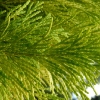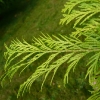Features
Bright yellow/green evergreen foliage, compact shape and relatively low maximum height (for a conifer!) make this a useful garden specimen shrub.
What to use it for
Generally used as a ’specimen’ shrub/tree in a conifer display or a mixed border or bed. Can also be used in hedging.
How to look after it
Generally these conifers do not require a lot of looking after, except for the pruning requirements outlined below, which are relatively minimal.
Any splayed out growth which is undamaged should be tied back into a main stem using a soft material such as soft twine, a rubber tree tie or even some stockings! Equally, any bare patches can be covered by tying healthy growth across the bare patch in the same way.
How to prune it
One important thing to remember when pruning this plant is that new growth will not come from older wood. If you have a big Chamaecyparis in your garden and chop it back, all those patches of bare, old wood will remain bare. If you want a well trimmed Chamaecyparis hedge, you need to start trimming it from the start. If you have a tree which is already too big, you need to remove it and start again.
To grow this as a single shrub or tree, early training will give you a better chance of having a well-shaped tree, although this isn’t a necessary task.
Any conifer pruning should ideally be done in autumn to midwinter – many conifers bleed sap and resins profusely from early spring to mid summer and this can weaken the plant.
Pruning of an established single shrub or tree should focus on removing any damaged, diseased, dead or congested growth from the base of the affected stem. With a hedge, the plants should be cut back twice a year to maintain the required shape and height. This is best done in late winter (before the new growth starts) and autumn.
How to propagate it
Easiest done by cuttings, which can be taken at almost any time. The best time to take them is as semi-ripe cuttings (so long as they are not too woody at the base) from late summer to mid autumn. The cuttings should be kept humid (eg under plastic film) with bottom heat of up to 20˚C. They will take 6 to 9 months to root.
Seeds can also be extracted in the spring from female cones which are one year old. Store them in the fridge, then sow them with a bottom heat of 15˚C, transplanting the seedlings into pots to grow on in midsummer. However, it is unlikely that the seeds will come true to the cultivar’s form.
Alternatively, for the more experienced, ‘Erect Aurea’ can be grafted onto a 2 year old seedling of a Chamaecyparis Lawsoniana. Apply heat of about 20˚C to the graft and this should form a callus after a few weeks.
Common problems
Can be susceptible to honey fungus and Phytophthora root diseases. May also be attacked by pests such as aphids (which cause die back), juniper scales and shoot-boring moths.
Other useful information
Foliage may cause a mild skin irritation.
The ‘lawsoniana’ species is named after the Lawson nursery in Edinburgh, UK, where the Chamaecyparis lawsoniana seeds were originally grown after being brought back from Northern California by William Murray in the mid 1800s. Murray had discovered the plant on a trip to find fellow botanist, John Jeffrey, who had mysteriously disappeared and was never found!








